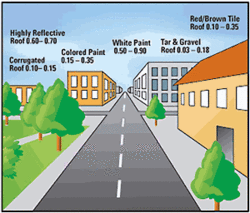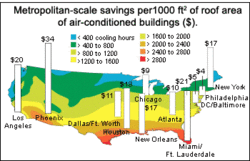Roofing materials
Contents
- 1 Cool roofs
- 1.1 Introduction The Utah Olympic Oval uses cool roof technology. Photo: EPA Cool roofs are highly reflective materials that stay 50 to 60 degrees F cooler in the summer sun, thereby reducing energy (Cool roofs) costs, improving occupant comfort, cutting maintenance costs, increasing the life cycle of the roof, and contributing to the reduction of urban heat islands and associated smog.
- 1.2 Characteristics of cool roofs
- 1.3 Benefits of cool roofs
- 1.4 Further reading
Cool roofs
| Topics: |
Introduction The Utah Olympic Oval uses cool roof technology. Photo: EPA Cool roofs are highly reflective materials that stay 50 to 60 degrees F cooler in the summer sun, thereby reducing energy (Cool roofs) costs, improving occupant comfort, cutting maintenance costs, increasing the life cycle of the roof, and contributing to the reduction of urban heat islands and associated smog.
Most roofs of urban buildings are dark-colored. These low-reflectance surfaces reach temperatures of 150 to 190°F (66 to 88°C) and contribute to:
- Increased cooling energy use and higher utility bills;
- Higher peak electricity demand, raised electricity production costs, and a potentially overburdened power grid;
- Reduced indoor comfort;
- Increased air pollution due to the intensification of the "heat island effect"; and
- Accelerated deterioration of roofing materials, increased roof maintenance costs, and high levels of roofing waste sent to landfills.
In contrast, cool roofs consist of materials that very effectively reflect the sun's energy from the roof surface. Cool materials for low-slope roofs are mainly bright white in color, although non-white colors are starting to become available for sloped roof applications. Cool Roofs must also have high thermal reflectance, allowing them to emit infrared energy. Unfortunately, bare metals and metallic coatings tend to have low emissivity and are not considered cool materials.
Characteristics of cool roofs
Cool roof materials have two important surface properties: a high solar reflectance – or albedo – and a high thermal emittance. Solar reflectance is the percentage of solar energy that is reflected by a surface. Thermal emittance is defined as the percentage of energy a material can radiate away after it is absorbed.
Cool roofs reflect heat well across the entire solar spectrum, especially in the infrared and visible wavelengths. The less solar radiation materials absorb, the cooler they are. In addition to absorbing less heat, the coolest roofing materials radiate away any absorbed heat.
Solar reflectance and thermal emittance have noticeable effects on temperature. Conventional roof surfaces have low reflectance (0.05 to 0.25) and high thermal emittance (typically over 80%) and heat up to 150 to 190°F (66 to 88°C) at midday during the summer. Bare metal or metallic surfaced roofs have high solar reflectance (0.5 or higher) and may have low thermal emittance (20 to 60%, depending on their surface treatment) and warm to 140 to 170°F (60 to 77°C). Cool roofs with both high reflectance and high emittance warm to only 100 to 120°F (38 to 49°C) in the summer sun.
Most cool roof applications have a smooth, bright white surface to reflect solar radiation, reduce heat transfer to the interior, and save on summertime air conditioning. These properties also can extend the life span of a roof. By limiting the quantity of absorbed solar energy, damage from ultraviolet radiation and daily temperature fluctuations – which cause repeated contraction and expansion – can be reduced. A range of cool roof products are available for use in low-sloped (mainly commercial) and sloped (mainly residential) building applications.
Materials for cool roofs
Products for low-slope roofs, found on commercial and industrial buildings, fall into two categories - single-ply materials and coatings. Single-ply materials are large sheets of pre-made roofing that are mechanically fastened over the existing roof and sealed at the Seams. Coatings are applied using rollers, sprays, or brushes, over an existing clean, leak-free roof surface.
Products for sloped roofs, usually found on residences, are currently available in clay, or concrete tiles. These products stay cooler by the use of special pigments that reflect the sun's infrared heat. Lower-priced shingles or coated metal roofing products are not yet available in "cool" versions
The solar reflectance of cool roofs tends to decrease over time. This is because surface particles like dew, dust, and air pollutants accumulate. Another factor that affects long-term solar reflectance is slope – the greater the angle of roof slope, the more dirt and particles dislodge and fall off the roof surface. Studies done at the Florida State Energy Center show that during the first two years of a cool roof's life span, solar reflectance can deteriorate up to 11% if regular maintenance is not provided.
Research on cool roof coatings by the Department of Energy's Lawrence Berkeley National Laboratory (LBNL) quantifies the effects of weathering and dirt accumulation. The results of the study show that solar reflectance decreases most in the first year (with an average reduction of 0.15) but that the magnitude of reductions decreases in later years.
Another LBNL study showed that washing a weathered cool roof membrane resulted in a significant solar reflectance increase. This indicates that if a roof collects large amounts of particulate matter or leaf debris, washing the roof every few years can help maintain high solar reflectance. LBNL recommends considering resistance to dirt accumulation among other factors when selecting a cool roofing material.
Another way to address the issue of declining albedo values is to reapply roof coatings periodically. Some roof coating distributors recommend applying a new coat after 10 years.
Benefits of cool roofs
One of the largest benefits of cool roofs is the potential reduction in energy use and energy costs. Annual electricity bills are less due to a reduction in summer air conditioning costs, and peak electricity demand costs are reduced if you have time-of-use metering. An estimate of cool roof energy savings can be determined by considering the following factors:
- Air conditioning: cool roofs can reduce summertime energy use in air conditioned buildings. In buildings without air conditioning, cool roofs can improve comfort by reducing top-floor temperatures.
- Roof insulation: cool roofs save more energy when installed on buildings with low roof insulation.
- Attic radiant barrier: these structures reduce the energy saving potential of cool roofs.
- Attic ventilation: buildings with low attic ventilation see a greater benefit from a reflective roof.
- Local climate: cooling energy savings are typically greatest in areas with long, sunny, hot summers.
Other benefits of cool roofs include reduced roof maintenance and replacement expenses by extending roof life; increased indoor comfort in summer by reflecting heat from the roof surface; reduced heat island effect in cities and suburbs; reduced air pollution and smog formation; reduced roofing waste added to landfills; and assistance to builders and building managers to meet local energy efficiency building standards.
Further reading
Heat Island Group, Lawrence Berkeley National Laboratory
| Disclaimer: This article is taken wholly from, or contains information that was originally published by, the Environmental Protection Agency and California Energy Commission. Topic editors and authors for the Encyclopedia of Earth may have edited its content or added new information. The use of information from the Environmental Protection Agency and California Energy Commission should not be construed as support for or endorsement by that organization for any new information added by EoE personnel, or for any editing of the original content. |

